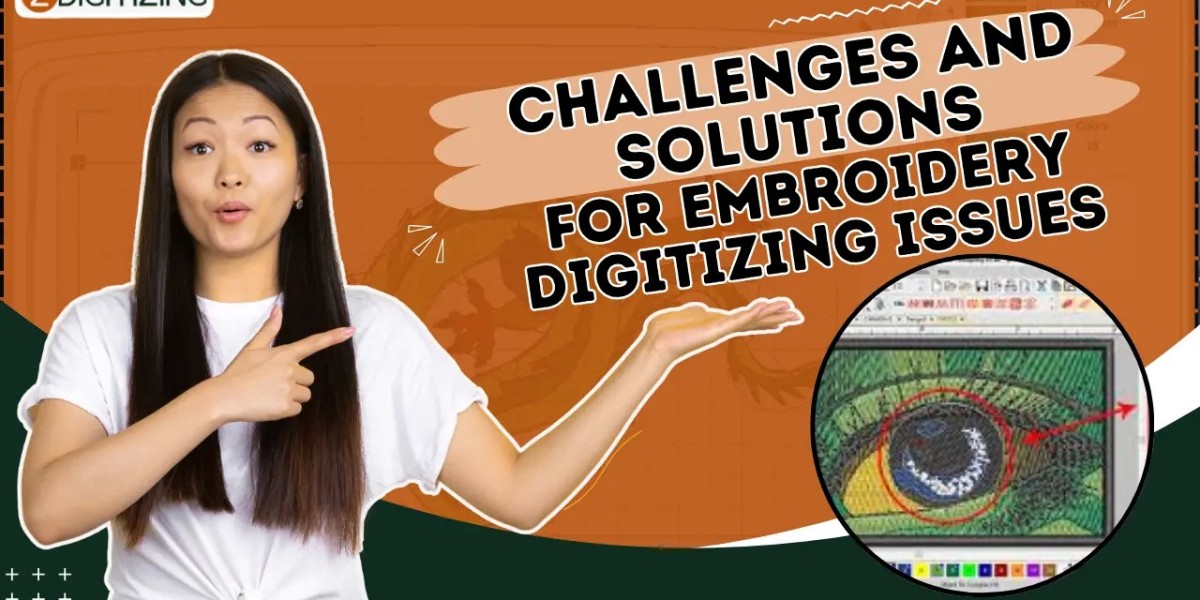Embroidery digitizing is a meticulous craft that bridges the digital and tactile worlds, transforming intricate designs into stitched masterpieces. However, like any art form, it comes with its unique set of challenges. In this comprehensive guide, we will explore common challenges faced during embroidery digitizing and provide practical solutions to overcome these issues. Whether you're a seasoned digitizer or a novice enthusiast, mastering these solutions will empower you to elevate your embroidery projects.
Challenge 1: Inconsistent Stitching
Cause:
Inconsistent stitching, where the density and appearance of stitches vary, can occur due to improper digitizing settings or issues with the embroidery machine's tension.
Solution:
Check Digitizing Settings: Review the settings in your embroidery digitizing software. Ensure that the stitch length, density, and underlay settings are appropriate for the fabric and design complexity.
Machine Tension Adjustment: If the issue persists, check and adjust the tension on your embroidery machine. Proper tension ensures even and consistent stitching. Refer to your machine's manual for guidelines on tension adjustment.
Challenge 2: Distorted Lettering or Small Details
Cause:
Distortion of lettering or small design details can occur when the digitized design is too small for the selected fabric or when the thread tension is too tight.
Solution:
Optimal Design Size: Ensure that the size of your digitized design is suitable for the chosen fabric. Small details may not stitch well on thick or textured fabrics. Resize the design accordingly in your digitizing software.
Adjust Tension: Loosen the thread tension on your embroidery machine, especially when working with smaller details. This prevents excessive pulling on the fabric and minimizes distortion.
Challenge 3: Thread Breakage
Cause:
Thread breakage can be caused by various factors, including inadequate tension, blunt needles, or issues with the digitized design, such as excessive stitch density.
Solution:
Check Tension: Ensure that the thread tension on your embroidery machine is correctly adjusted. Too much tension can cause breakage. Experiment with different tension settings based on the thread and fabric you are using.
Inspect Needles: Regularly inspect and replace needles to prevent breakage. Blunt or damaged needles can snag on the fabric and disrupt the embroidery process.
Optimize Stitch Density: Review the stitch density in your digitized design. Excessive density can lead to increased friction and contribute to thread breakage. Adjust the density settings in your digitizing software as needed.
Challenge 4: Misalignment of Elements
Cause:
Misalignment issues arise when elements within the design, such as text or shapes, do not align correctly during embroidery digitizing services.
Solution:
Grid and Guidelines: Utilize the grid and guidelines features in your digitizing software. These tools help you maintain alignment and spacing between elements. Snap elements to the grid to ensure precision.
Reference Points: Establish reference points within your design to guide proper alignment. This is particularly important for multi-part designs where elements need to align seamlessly.
Test Stitch on Scrap Fabric: Before embroidering on the final fabric, conduct a test stitch on scrap fabric to identify and address any alignment issues. This allows you to make adjustments without compromising the intended project.
Challenge 5: Limited Thread Color Options
Cause:
Limited thread color options can restrict the vibrancy and accuracy of your digitized design, especially when trying to match specific colors.
Solution:
Color Conversion Tools: Explore color conversion tools in your digitizing software. These tools allow you to adjust the thread colors in your design to match the available thread colors in your inventory.
Custom Color Palettes: Create custom color palettes based on the thread colors you have. This ensures that your digitized design is tailored to the available thread options, maintaining color accuracy.
Challenge 6: Complexity in Multi-Part Designs
Cause:
Multi-part designs, such as those with intricate details or different elements, can pose challenges in maintaining consistency and alignment.
Solution:
Grouping Elements: Group related elements together in your digitizing software. This simplifies the organization of complex designs and ensures that individual parts maintain their relationships during the embroidery process.
Use Color Stops: Implement color stops strategically. This allows you to control the sequence in which different parts of the design are embroidered, aiding in the organization and alignment of multi-part designs.
Stitch Sequence Planning: Plan the stitch sequence thoughtfully, considering the order in which different elements are embroidered. This can minimize thread jumps and reduce the risk of misalignment.
Challenge 7: Difficulty in Digitizing Fine Details
Cause:
Digitizing fine details, such as intricate patterns or small lettering, requires precision and skill. Inadequate digitizing settings can lead to loss of detail.
Solution:
Use the Right Needles: Employ sharp and fine needles for digitizing fine details. Needles with smaller diameters are better suited for capturing intricate details without sacrificing clarity.
Adjust Stitch Length: Experiment with the stitch length settings in your digitizing software. Finer details may require shorter stitch lengths to capture the intricacies of the design accurately.
Focus on Underlay: Pay attention to underlay settings. Adequate underlay provides a stable foundation for fine details and prevents distortion during embroidery.
Challenge 8: Lack of Training or Experience
Cause:
Embroidery digitizing is a skill that requires training and experience. Lack of familiarity with digitizing software and techniques can result in suboptimal designs.
Solution:
Training Programs: Enroll in embroidery digitizing training programs or workshops. Many online and in-person courses offer comprehensive training on using digitizing software and mastering embroidery techniques.
Practice Regularly: Practice is key to improving digitizing skills. Dedicate time to experimenting with different features in your digitizing software and working on sample designs to enhance your proficiency.
Join Online Communities: Engage with online communities and forums dedicated to embroidery digitizing. Participating in discussions, seeking advice, and sharing experiences with fellow digitizers can contribute to continuous learning.
Conclusion
Embroidery digitizing is an intricate art that requires a blend of creativity, technical expertise, and problem-solving skills. By addressing common challenges head-on and implementing the suggested solutions, you can navigate the complexities of digitizing with confidence. Whether you're troubleshooting thread breakage or refining the alignment of multi-part designs, these solutions will empower you to overcome obstacles and create stunning embroidered works of art.
Zdigitizing
ZDigitizing is offering a wide range of digitizing solutions to meet the needs of vector artwork services businesses and individuals alike. With expertise in logo digitizing, 3D puff digitizing, cap digitizing, and applique digitizing, zdigitizing ensures high-quality and precise embroidery designs.
Their team of skilled embroidery digitizer is well-versed in converting images to embroidery digitizing, making it easy to transform your logos, artwork, or designs into stitch files. Whether you have a PNG or JPG image, ZDigitizing can seamlessly convert it into embroidery-ready files, ensuring accurate reproduction of intricate details and vibrant colors.








